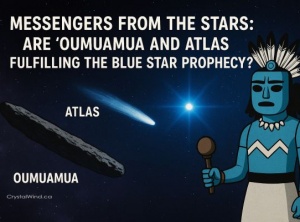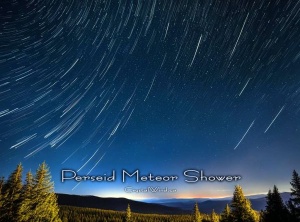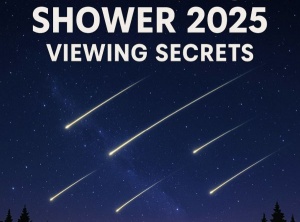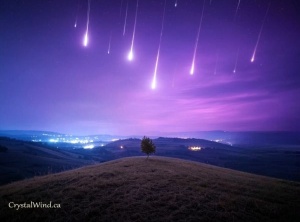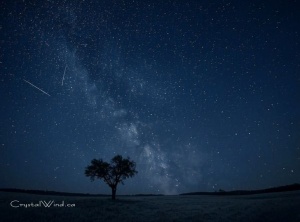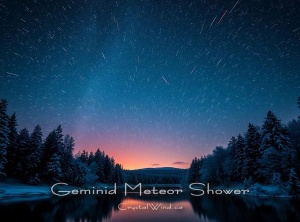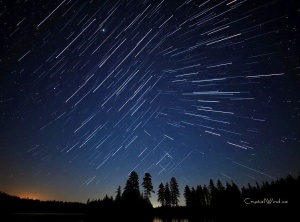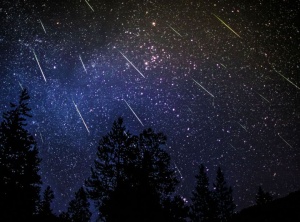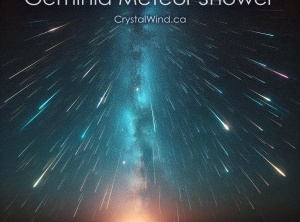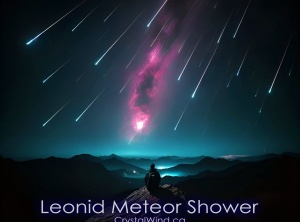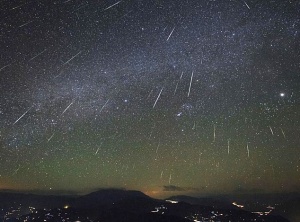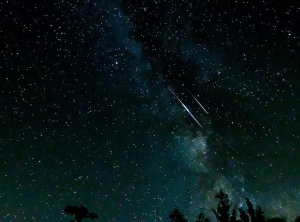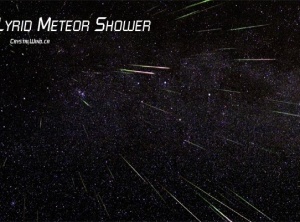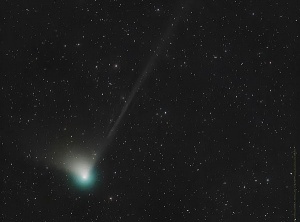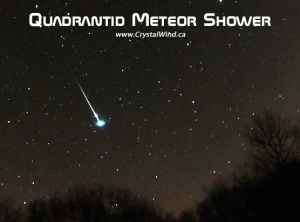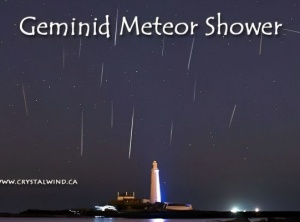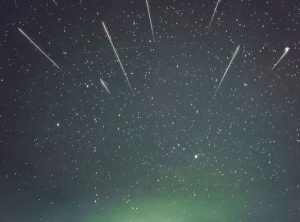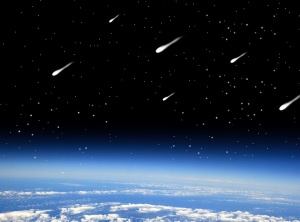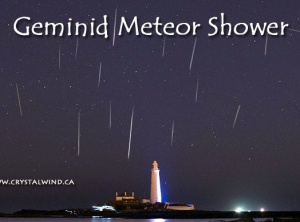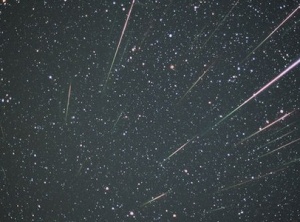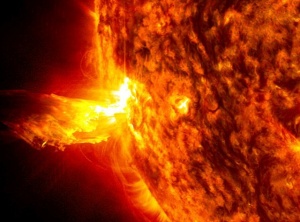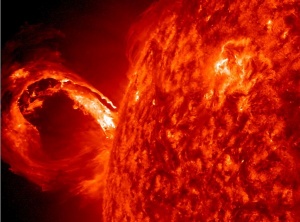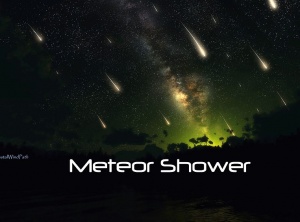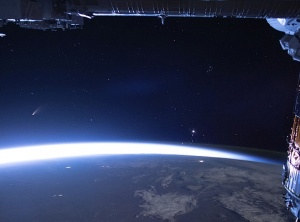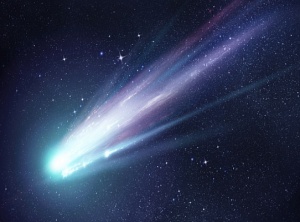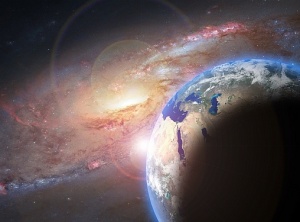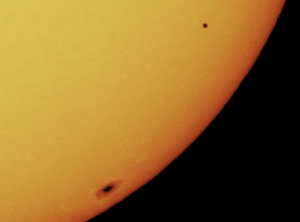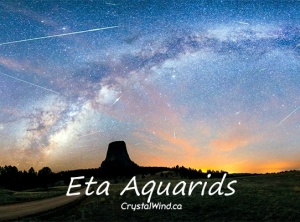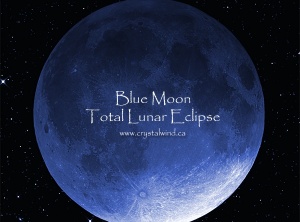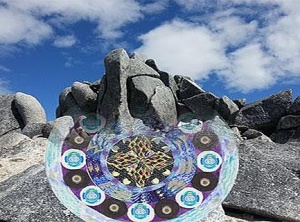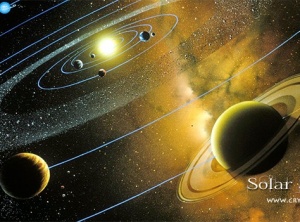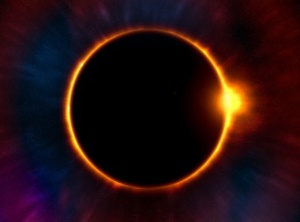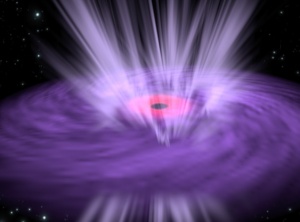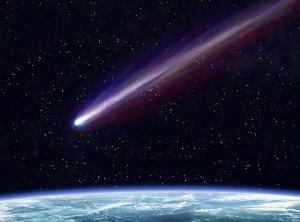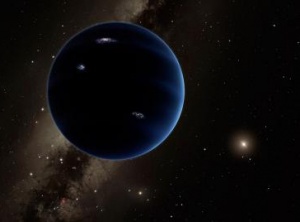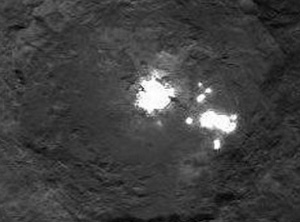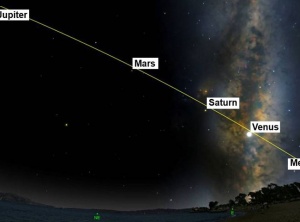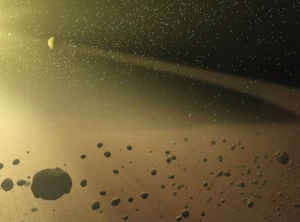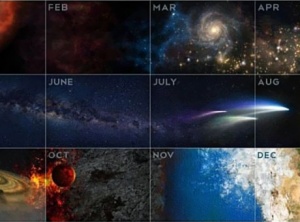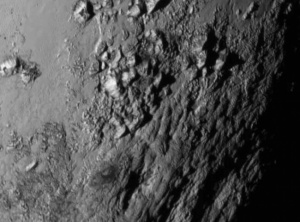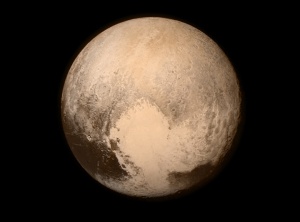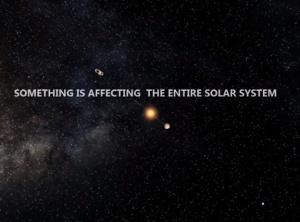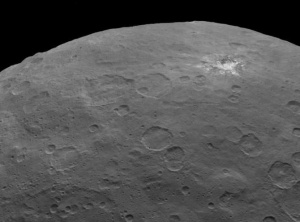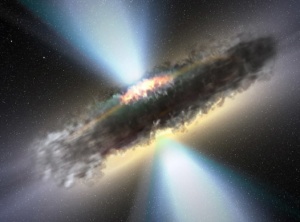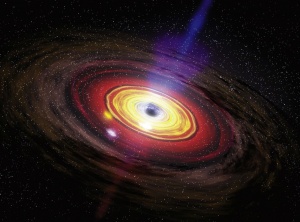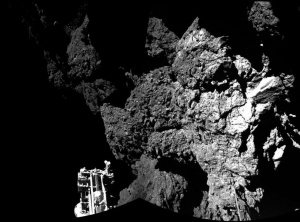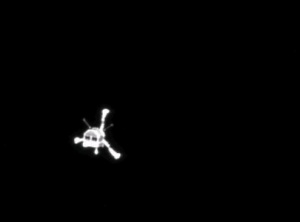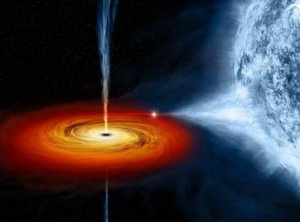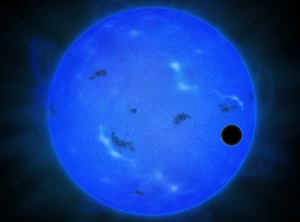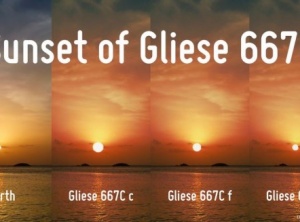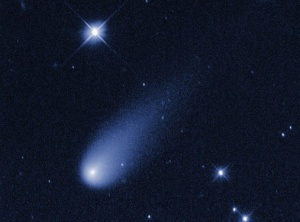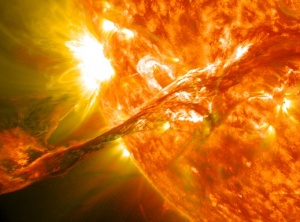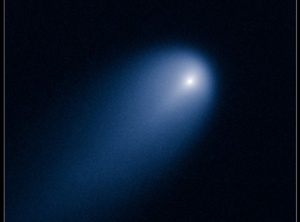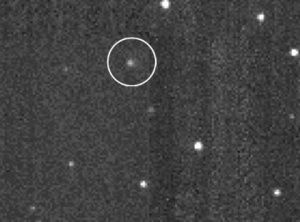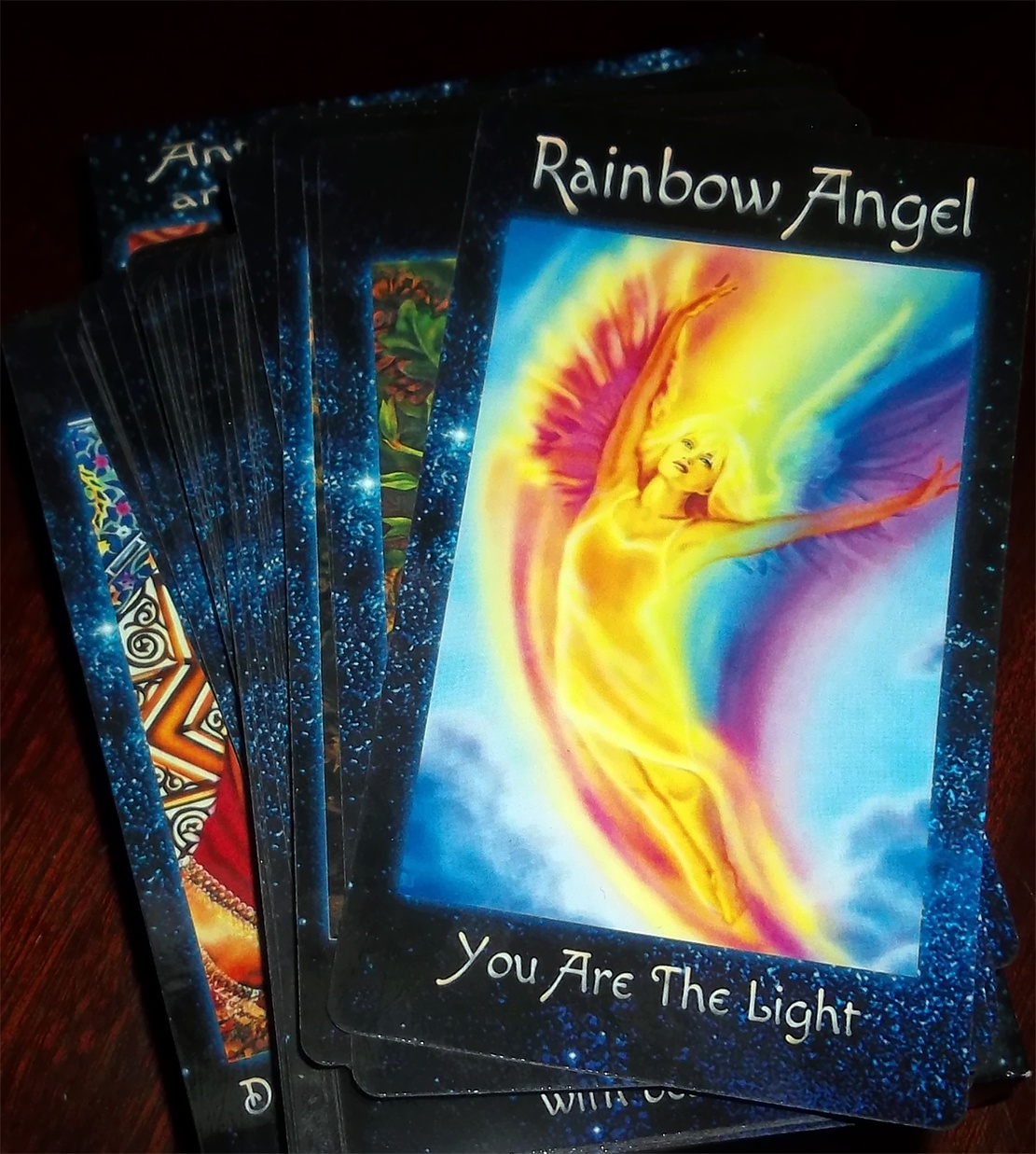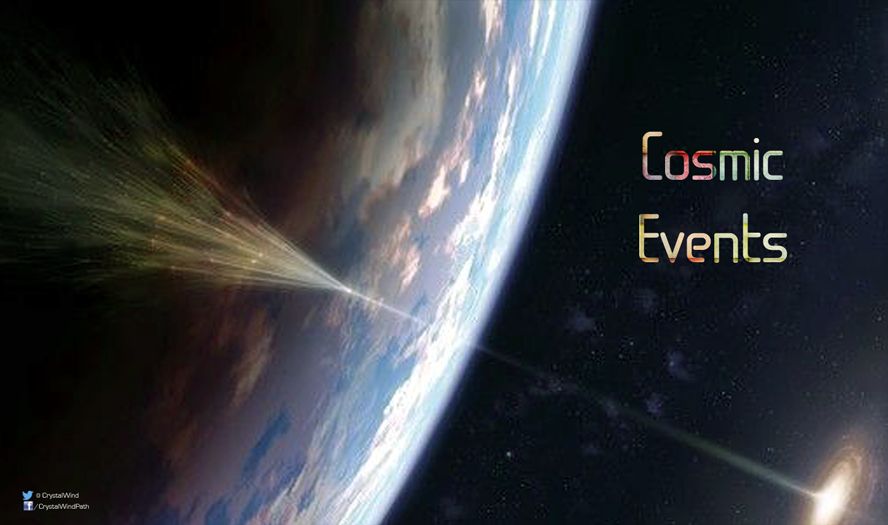
Cosmic events are astronomical events which take place in the vast outer space, but of great significance to the earth also. The conjunctions of planets, meteoric showers, etc., are examples of cosmic events. Cosmic also means great, vast, or very important.
A disaster of cosmic dimensions means a disaster on a very large-scale causing great suffering to a lot of people. In the course of their orbits, certain stars and planets come very close to the Solar System or the Earth, and they are cosmic events, which are of great significance to the earth.
Eureka: Cosmic - Cosmic Events
Blue Star Prophecy: Are ʻOumuamua and ATLAS the Signs?
Messengers from the Stars For millennia, humanity has watched the heavens with awe, seeking signs among the wandering lights. Read more
Perseid Meteor Shower 2025: Peak Dates and Viewing Tips
The 2025 Perseid meteor shower is one of the most anticipated celestial events of the year. Renowned for its bright, colorful meteors and frequent fireballs, it offers a breathtaking display that has captivated stargazers for centuries. Read more
Lyrid Meteor Shower 2025: Peak Dates and Viewing Guide
The Lyrid Meteor Shower: Nature's Spring Light Show Returns Break out your lawn chairs and blankets — the cosmic drought is finally over. After months of quiet skies, the Lyrid meteor shower is about to paint the heavens with streaks of light, marking the first major meteor shower of spring 2025. Read more
Meteor Showers Calendar: Must-See Dates for 2025-2026!
A Celestial Spectacle: Your Detailed Meteor Shower Calendar for 2025-2026. Read more
Ursid Meteor Shower 2024: A Winter Sky Spectacle
In 2024, the Ursid Meteor Shower will peak on December 22-23, offering a breathtaking display of up to 50 meteors per hour. This celestial event, originating from Comet 8P/Tuttle, transforms the winter sky into a dazzling spectacle. Perfect for both seasoned astronomers and casual stargazers, the Ursid Meteor Shower is a must-s... Read more
Geminid Meteor Shower 2024: Viewing Guide & Tips
Get ready, stargazers! The Geminid meteor shower is coming in 2024. It's one of the most amazing sights in the sky. You can see up to 120 meteors per hour at its peak. Read more
Orionid Meteor Shower 2024 Is a Must-See Event
The 2024 Orionid Meteor Shower is a highly anticipated event that draws stargazers from around the world. Read more
Cosmic Showers: A Guide to the Draconid Meteor Display of 20…
The Draconid meteor shower will be active from October 6 to October 10, 2024, with meteors reaching their peak around October 8-9. At around 21:00 EDT on October 8, 2024, the shower is expected to reach its peak activity. Read more
Perseid Meteor Shower 2024: Stargazing Spectacle
The 2024 Perseid meteor shower is a must-see event in the sky. It's known for its bright and colorful trails. Read more
Embracing the Celestial Show: The Annual December Ursid Mete…
The Ursids, a lesser-known meteor shower, make their grand entrance annually, typically spanning from December 13 to 24. Read more
Geminid Meteor Shower 2023: Dates, Viewing Tips, and Celesti…
The Geminid meteor shower, a celestial spectacle cherished by skywatchers across the globe, returns in 2023, promising a breathtaking display of shooting stars. Read more
Gaze Up at the Night Sky: The Leonid Meteor Shower 2023
Every year, stargazers and astronomy enthusiasts anticipate the arrival of meteor showers, those captivating displays of celestial fireworks that light up the night sky. Read more
Orionid Meteor Shower - 2023
From 2 October to 7 November, the Orionid meteor shower will be active; its peak rate of meteor production will occur around 22 October. Read more
Perseid Meteor Shower 2023
The Perseid meteor shower is set to reach its peak on the night of August 12 and the early hours of August 13, 2023. Read more
Lyrid Meteor Shower - 2023
The yearly meteor drought, which lasts from January to mid-April each year, is invariably broken by the Lyrid meteor shower. The Lyrid meteor shower is an annual event that occurs between April 15 and April 29, with its peak expected on April 23 at 1:06 UTC in 2023. Read more
In January And February, A Bright Green Comet Will Race Acro…
In January and February, a recently found comet will whiz across the sky. Read more
Quadrantid Meteor Shower - 2023
The Quadrantid meteor shower is 2023’s first major meteor shower. From 12 December to 12 January, the Quadrantid meteor shower will be active, with its peak meteor production occurring Tuesday and Wednesday, January 3-4, 2023. Read more
Geminid Meteor Shower - 2022
The Geminid meteor shower is one of the finest meteors showers visible in either the Northern or the Southern Hemisphere. From December 4 to December 17, the Geminid meteor shower will be active, reaching its peak meteor production on December 14th. Read more
Leonid Meteor Shower 2022
The Leonid meteor shower will be active from November 3 to December 2, producing its peak rate of meteors around November 17-18. Although only 10-15 meteors are created an hour, half of them leave a long-lasting trail across the sky. Under a dark sky, with no moon, you might see 10 to 15 Leonid meteors per hour. Read more
Taurid Meteor Shower - 2022
From October 20 through December 10, the Northern Taurid meteor shower will be active, with its peak meteor production occurring around November 12. Every night from October 20 to November 30 you should witness a few shooting stars associated with the shower. Read more
Orionid Meteor Shower - 2022
The Orionid meteor shower should peak in 2022 on the morning of October 21-22 under the light of a fairly small waning crescent moon. The Orionid meteor shower will remain active until early November. Read more
Draconid Meteor Shower - 2022
The Draconid meteor shower will be active between October 6 and October 10, with meteors reaching a peak around October 8-9. At around 21:00 EDT on October 8, 2022, the shower is expected to reach its peak activity. Read more
Perseid Meteor Shower 2022
In 2022, the peak mornings for the Perseid meteor shower – August 11, 12 and 13 – will feature meteors under moonlight. Due to the full moon's illumination of the sky, the Perseids in 2022 won't be as as brilliant as they were in 2021. Here’s how to optimize your chances to catching some meteors during this year’s display. Read more
Quadrantid Meteor Shower - 2022
The Quadrantid meteor shower is 2022’s first major meteor shower. We’ll have moon-free skies during the predawn hours on January 4 for this year’s peak, expected late night January 3 until dawn January 4. Although the Quadrantids have been known to produce some 50-100 meteors in a dark sky, their peak is extremely narrow, ... Read more
Stellar Video Shows Comet Leonard as It Zips by Earth For Th…
Since early this year, skywatchers on Earth have been tracking Comet Leonard, a kilometer-wide dirty snowball made of ice, rock, and dust. Now, as it heads towards a close encounter with the Sun on 3 January 2022, several spacecraft – with the distinct advantage of having an unobstructed front-row seat to the action – have been ... Read more
Ursid Meteor Shower - The Winter Solstice 2021
The Ursids meteor shower is active annually between December 17 and December 26. The annual Ursid meteor shower runs from about December 17 to 26 each year and always peaks around the December solstice, which, in 2021, comes on December 21. The shower’s peak is probably the morning of December 22, but any of the next ... Read more
Geminid Meteor Shower - 2021
The Geminid meteor shower is one of the finest meteors showers visible in either the Northern or the Southern Hemisphere. The Geminid meteor shower will be active from 4 December to 17 December, producing its peak rate of meteors around 14 December. Read more
Leonid Meteor Shower 2021
The Leonid meteor shower will be active from November 6-30, producing its peak rate of meteors around November 17-18. Although only 10-15 meteors are created an hour, half of them leave a long-lasting trail across the sky. Leonids will peak during bad moon conditions and the moon will be 95% full on the night of Nov. 16. ... Read more
Orionid Meteor Shower - 2021
The Orionid meteor shower will peak on in the early morning of Wednesday, Oct. 20, but the moon will be full on the same night and will likely wash out the display. This year skywatchers in both the Northern and Southern Hemispheres can expect to see rates of up to 20 meteors per hour, but only under the best conditions away fr... Read more
Forecast of Solar and Geomagnetic Activity 30 August - 25 Se…
Solar activity is expected to be at moderate levels from 30 Aug - 03 Sep with Region 2860 rotating off the visible disk on 04 Sep. Moderate levels are also likely on 16-25 Sep as Region 2860 rotates back onto the visible disk. Very low levels are expected on 04-15 Sep. No proton events are expected at geosynchronous orbit. Read more
Coronal Mass Ejections - CME's
What Are Coronal Mass Ejections? Every so often, the sun burps, with the power of 20 million nuclear bombs. These hiccups are known as coronal mass ejections or CMEs. They are powerful eruptions near the surface of the sun, driven by kinks in the solar magnetic field. The resulting shocks ripple through the s... Read more
Perseid Meteor Shower 2021
In 2021, the peak mornings for the Perseid meteor shower – August 11, 12 and 13 – will feature meteors under moonlight. Here’s how to optimize your chances to catching some meteors during this year’s display. The annual Perseid meteor shower is one of the most beloved meteor showers of the year, especially in the Northern Hemi... Read more
Ursid Meteor Shower - The Winter Solstice 2020
The Ursids meteor shower is active annually between December 17 and December 26. The annual Ursid meteor shower runs from about December 17 to 26 each year and always peaks around the December solstice, which, in 2020, comes on December 21. The shower’s peak is probably the morning of December 22, but any of the next ... Read more
Geminid Meteor Shower - 2020
The Geminid meteor shower is one of the finest meteors showers visible in either the Northern or the Southern Hemisphere. The Geminid meteor shower will be active from 4 December to 17 December, producing its peak rate of meteors around 14 December. Read more
Orionid Meteor Shower - 2020
The Orionid meteor shower will peak around mid-week, with the best morning likely being Wednesday, October 21. Try watching on the mornings of October 20 and 22, too. In 2020, the moon will be a waxing crescent at the shower’s peak. That means the moon will set in the evening hours, or before the constellation Orion – the radia... Read more
Perseid Meteor Shower 2020
In 2020, the peak mornings for the Perseid meteor shower – August 11, 12 and 13 – will feature meteors under moonlight. Here’s how to optimize your chances to catching some meteors during this year’s display. The annual Perseid meteor shower is one of the most beloved meteor showers of the year, especially in the Northern Hemi... Read more
The Delta Aquarid Meteor Shower - 2020
The Delta Aquariid shower favors the Southern Hemisphere, though is still visible from mid-northern latitudes. In years when the moon is out of the way, the broad maximum of this shower can be expected to produce 10 to 20 meteors per hour. But, even in early August, you’ll likely see some Perseids, too. This shower overlaps wit... Read more
Comet NEOWISE Predictions
Comet NEOWISE from the ISS, July 10, 2020 [apod.nasa.gov] Comet NEOWISE is one of the brightest comets for over 20 years, and one of the few comets visible to the naked eye this century. It was discovered using the NEOWISE space telescope on March 27, 2020. Comets have always inspired awe as well as dread. Seen as carrying me... Read more
Comet NEOWISE is Now Visible With the Naked Eye
People waking up early in the morning will be treated to a brilliant site this week. People waking up early in the morning will be treated to a brilliant site this week: the newly discovered comet NEOWISE, which is the first visible comet of 2020 that can be seen with the naked eye. Officially known as C/2020 F3, the comet wa... Read more
Earth Is About To Enter A 30-Year ‘Mini Ice Age’ As A 'Solar…
Earth is bracing for a solar minimum: a dormant period in which the Sun radiates less energy or heat at our planet than usual. Scientists have warned that as a result of the Sun’s inactivity, Earth is likely to witness a ‘mini ice age’ that could bring extreme winters and chilly cold storms over the next 30 years. According to... Read more
Quadrantid Meteor Shower - 2020
The Quadrantid meteor shower is 2020’s first major meteor shower. We’ll have moon-free skies during the predawn hours on January 4 for this year’s peak, expected late night January 3 until dawn January 4. Although the Quadrantids have been known to produce some 50-100 meteors in a dark sky, their peak is extremely narrow, ... Read more
Ursid Meteor Shower - The Winter Solstice 2019
December 17, 2019 might be your first night for seeing meteors in the annual Ursid meteor shower. This shower typically peaks around the December solstice, which, in 2019, comes on December 21 or 22, depending on your time zone. The shower’s peak morning is probably December 22. Look at the sky in the morning on the ... Read more
Geminid Meteor Shower - 2019
Around the world, the shower will peak on 13 December or 14 December, depending on your time zone. Even after the peak, bright meteors may be visible for the next few days. The Geminid meteor shower is one of the most anticipated events in the stargazing calendar as more than 120 shooting stars per hour are set to sp... Read more
Alpha Monocerotids - Meteors From The Unicorn
This Thursday night (November 21-22, 2019) – if you’re on the right part of Earth, and are looking at exactly the right time in a dark, clear sky – you have a good chance of witnessing a brief but very rich outburst of meteors known as the alpha Monocerotids. They will radiate from the constellation Monoceros the... Read more
Mercury Transit on 11-11, 2019
On November 11, we will see the planet Mercury move in front of the Sun for the first time since 2016, and the last time until 2032! When: Monday, November 11, 4:35 a.m. to 10:04 a.m. PST Read more
Taurid Meteor Shower - 2019
On 4-6 November, 2019, the Northern Taurid meteor shower will reach its maximum rate of activity with 5 to 10 meteors per hour. Some shooting stars associated with the shower are expected to be visible each night from October 20th to November ... Read more
Leonid Meteor Shower 2019
Leonids | 16-17 November 2019 Coming from Leo, the Leonids happen from November 14 through November 21, with a peak on November 17. Although only 10-15 meteors are created an hour, half of them leave a long-lasting trail across the sky. However on November 17, there will be a waning gibbous moon, making any kind of meteor diffi... Read more
Orionid Meteor Shower - 2019
The Orionid meteor shower is set to peak on the night of Oct. 22-23, but a bright moon will disrupt viewing until shortly before dawn. The meteors that streak across the sky are some of the fastest among meteor showers, because the Earth is hitting a stream of particles almost head on. The annual Orionids meteor shower, compos... Read more
Draconid Meteor Shower - 2019
October’s Draconid meteor shower – sometimes called the Giacobinids – is expected to peak at nightfall or early evening on October 8, 2019, though under a moon-drenched sky. Try watching the evenings of October 7 and 9, too. Read more
Perseid Meteor Shower 2019
The 2019 Perseid meteor shower will probably produce the greatest number of meteors on the mornings of August 11, 12 and 13. Unfortunately, on the peak mornings in 2019, a bright moon will drown many Perseids from view. For those serious about seeing the greatest number of Perseids in 2019, we recommend viewing several mornings... Read more
The Delta Aquarid Meteor Shower - 2019
The Delta Aquarid meteor shower in July favors the Southern Hemisphere and tropical latitudes in the Northern Hemisphere. The meteors appear to radiate from near the star Skat or Delta in the constellation Aquarius the Water Bearer. The maximum hourly rate can reach 15-20 meteors in a dark sky. The Delta Aquarid meteor sho... Read more
Ursid Meteor Shower - The Winter Solstice 2018
The annual Ursid meteor shower always peaks near the time of the December solstice, so, in 2018, look for some possible activity over the next several nights. The forecast calls for the night of December 21-22 or December 22-23 to be the peak night. Normally a sparse shower, you might see about five meteors per hour. This showe... Read more
Geminid Meteor Shower - 2018
Around the world, the shower will peak on 13 December or 14 December, depending on your time zone. The Geminid meteor shower is one of the most anticipated events in the stargazing calendar as more than 120 shooting stars per hour are set to sparkle in the skies.The Geminid meteor shower is one of the most anticipated eve... Read more
Orionid Meteor Shower - 2018
The Orionid meteor shower is set to peak the night of Oct. 21-22, but the moon will lead to subpar views for this night sky display. The meteors that streak across the sky are some of the fastest among meteor showers, because the Earth is hitting a stream of particles almost head on. "The moon is going to mess with you," NASA ... Read more
Perseid Meteor Shower 2018
According to NASA meteor expert Bill Cooke, the Perseids are perhaps the most popular meteor shower of the year; and this year, they'll be the best shower of the year. This year during peak people should see about 60-70 meteors per hour, but in outburst years (such as in 2016) the rate can be between 150-200 meteors an hour. Th... Read more
The Delta Aquarid Meteor Shower - 2018
The Delta Aquarid meteor shower in July favors the Southern Hemisphere and tropical latitudes in the Northern Hemisphere. The meteors appear to radiate from near the star Skat or Delta in the constellation Aquarius the Water Bearer. The maximum hourly rate can reach 15-20 meteors in a dark sky. The Delta Aquarid meteor sho... Read more
Eta Aquarid Meteor Shower
The Eta Aquarid meteor shower is the first of two showers that occur each year as a result of Earth passing through dust released by Halley's Comet, with the second being the Orionids. The point from where the Eta Aquarid meteors appear to radiate is located within the constellation Aquarius. Sadly, this location is a bit ... Read more
First Blue Moon And Total Lunar Eclipse in 150 Years!
The first total lunar eclipse of this year comes at the very end of the month, on January 31st. It is going to be a total eclipse that will also involve the second Full Moon of the month, which is popularly referred to as a Blue Moon. Such kind of a sky-watching event has not happened for more than 150 years. This e... Read more
2018 Cosmic Events
Mt Titiroa New Earth Crown & Gateway to the Cosmic Ocean mandala by Soluntra 2018 year of resurrection, an 11=2, year of the Earth Dog. Powerful events will unfold this year that have not been able to before because humanity was not ready. Now with the Unified Light Matrix firmly anchored through us and the Grea... Read more
Quadrantid Meteor Shower
2019 is a decent year to see the annual Quadrantid meteor shower — especially in Europe — during its sharp peak the night of Jan. 3-4. "A lot of meteor showers last days — the Quadrantids last a few hours," NASA meteor expert Bill Cooke told Space.com. "Europe is favored to view the Quadrantids [because] th... Read more
Scientist Are Now Saying The Solar System Is Moving Into A N…
...That Is Transforming The Magnetic Fields Of The Planets. This is the Russian perspective on earth changes. Hard facts that are going unreported in America. The atmospheres of the planets are changing. Dr. Dmitriev’s work shows that the planets themselves are changing. They are undergoing changes in their atmospheres. For... Read more
Geminid Meteor Shower
The Geminid meteor shower is one of the most anticipated events in the stargazing calendar as more than 120 shooting stars per hour are set to sparkle in the skies.The Geminid meteor shower is one of the most anticipated events in the stargazing calendar as more than 120 shooting stars per hour are set to sparkle in the skies. ... Read more
Leonid Meteor Shower
In mid-November, spectacular "shooting stars" will streak through the night sky as the Leonid meteor shower hits Earth once again. This annual meteor shower, which peaks overnight on Nov 17, is responsible for some of the most intense meteor storms in history. Sometimes, meteors fall at rates as high as 50,000 per hour. These st... Read more
Draconid Meteor Shower
If you're neither a night owl nor an early riser, the upcoming Draconid meteor shower might be a good one for you to check out. Unlike many showers, which offer the best viewing in the hours before dawn, the Draconids are best observed this year just after dark. This weekend, a waning but still-bright gibbous moon will interfer... Read more
Perseid Meteor Shower: What You Need To Know
NASA expects up to 100 meteors per hour during the shower's peak. The annual Perseid meteor shower, known for its prolific offering of "shooting stars," is expected to be even more spectacular in 2017. The peak of the Perseid meteor shower will occur on Aug. 12-Aug. 13. The shower officially began on July 13 — when E... Read more
The Most Unusual (And Significant?) Solar Eclipse In U.S. Hi…
August 21st is the date of “the Great American Eclipse”, and the hype around it is already starting to reach a fever pitch. It is being called “the Great American Eclipse” because this will be the first total solar eclipse ever that is only visible in the United States. In other words, since the United States became a na... Read more
Black holes and high winds bad news for galaxies
For the first time, astronomers have measured winds associated with a black hole and found they blast along at a quarter of the speed of light. As in humans, it seems, so in deep space. After consuming large amounts at high speed, hot gas needs to be expelled. New measurements from NASA's Nuclear Spectroscopic Tele... Read more
Lunar Eclipse, Snow Moon and New Year comet are all visible …
Avid sky gazers are in for a treat tonight, when all three of these celestial events coincide IF you’re an avid sky watcher, tonight is the night you’ve been waiting for. Space enthusiasts, you’re in for a treat, as three celestial events are all happening on the same night... Read more
Rare Astrological Event: January 7th 2017 All Planets Are Mo…
Starting January 7th and going through February 6th, 2017, all of the major planets will be moving direct (forward). Ancients saw this as a time of great fortune and a very opportune time. Stephanie “Wave” Forest is the first known astrologer first to publish articles, teach online courses and p... Read more
Ursid Meteor Shower - The Winter Solstice
The annual Ursid meteor shower always peaks near the time of the December solstice, so, in 2017, look for some possible activity over the next several nights. The forecast calls for the night of December 21-22 or December 22-23 to be the peak night. Normally a sparse shower, you might see about five meteors per hour. This showe... Read more
Planet X Exists! Researchers See The Signs
The gravitational tug on outer solar system objects indicates this giant world -- if it exists -- would be 5,000 times more massive than Pluto and take up to 20,000 years to orbit the Sun. Caltech researchers have found evidence of a giant planet tracing a bizarre, highly elongated orbit in the distant solar sys... Read more
Unexpected Activity On The Ceres Asteroid - Bright Spots Are…
Ceres’ unusually bright spots. * Nestled 250 million miles from Earth, between the orbits of Mars and Jupiter, is the largest object in the asteroid belt: Ceres. It’s home to some of the most puzzling features ever observed in our solar system, including a giant pyramid that dwarfs many m... Read more
The Planetary Parade
Hi Lovely! As you may know, right now five bright planets are lined up in the sky for the first time since 2005. In their actual order based on distance from the sun, these bright planets -- Saturn, Jupiter, Mars, Venus and Mercury -- can be seen arranged together in a line, from Earth. This arrangement became... Read more
Taurid Meteor Shower
The Northern Taurid meteor shower will reach its maximum rate of activity on 11-12 November 2018 (11:11:11). Some shooting stars associated with the shower are expected to be visible each night from October 20th to November 30th. In 2018, th... Read more
Scientists can’t explain what huge object is blocking the li…
They say we actually need to consider the possibility of aliens. It’s not every day that we have permission to throw "Aliens?" out there in relation to a confounding astronomical discovery - in fact, I don’t think we ever have. But the discovery of a strange pattern of light surrounding a d... Read more
If Mars once had life, what happened to it?
After studying the red planet for decades, scientists admit that there is a great possibility that an impact of a asteroid or comet altered the faith of the Red Planet. Compared to Earth, Mars is full of impact craters. But that isn’t that strange since Mars has a very uncomfortable position in our sol... Read more
Calendar of Celestial Events for 2016
This calendar of celestial events contains dates for notable celestial events including moon phases, meteor showers, eclipses, oppositions, conjunctions, and other interesting events. Most of the astronomical events on this calendar can be seen with unaided eye, although some may require a good pair of binoculars for ... Read more
Stargate-like leap? Black holes could take us to ‘another un…
Find yourself in a black hole? Not to worry, says Stephen Hawking: you won’t split into particles or cease to exist. Instead, you’ll wind up in an alternative universe – but remember, it can only be a one-way trip. According to the celebrated physicist, the hole “would need to b... Read more
Blowing My Mind : Peaks on Pluto, Canyons on Charon
CAPE CANAVERAL, Fla. (AP) — Mankind's first close-up look at Pluto did not disappoint Wednesday: The pictures showed ice mountains on Pluto about as high as the Rockies and chasms on its big moon Charon that appear six times deeper than the Grand Canyon. Read more
Introducing .... Pluto ... July 14, 2015
3 billion miles later, the first ever photo of Pluto's surface is here. Well, hello, Pluto. Nice to finally meet you! 3 billion miles. That's quite a trek. It's more than a million road trips from New York City to Los Angeles. Or, for those of you who'd get carsick, roughly 32 trips to the sun. It's also about the distance ... Read more
Something is Affecting the Entire Solar System - Sun's Magne…
Strange things are happening in both outer and inner space scientists are discovering that the Solar System, the sun, and life itself are mutating in totally unprecedented ways. They are reporting changes that are being recorded in space that have never been seen before Studies show that the Sun and the planets them... Read more
3 Mile Tall Great Pyramid Spotted on Ceres by NASA's Dawn Sp…
As Dawn first made its approach on Ceres not long ago, it got a quick look at vast, splendid and secretive intelligent spots in a pit on the huge rock, which is additionally accepted to contain a lot of water, ice and/or mud in its inside. The mysterious bright spots on Ceres have been getting a lot of attention... Read more
Mystery radio waves from deep space captured LIVE, sender un…
An unknown radio signal, which may have come from a black hole, colliding neutron stars (or – for those who ‘believe’ – alien life), has been picked up by astronomers live for the first time ever. Its origins remain mysterious. The fast radio bursts are quick, bright flashes of radio wave... Read more
Galaxies spiral into each other, create spectacular light sh…
A new composite image of NGC 2207 and IC 2163 contains X-rays from Chandra X-Ray Observatory (X-ray: NASA/CXC/SAO/S.Mineo et al, Optical: NASA/STScI, Infrared: NASA/JPL-Caltech) Two colliding galaxies in the Canis Major constellation put on an impressive light display that was captured in a composite image using data fr... Read more
NASA says Black Hole at Milky Way center may be emitting mys…
The massive black hole at the heart of our milky galaxy may be churning out peculiar particles called neutrinos, NASA satellites have revealed. If verified, it would be the first time neutrinos have been traced to the darkest regions of spacetime. The subatomic activity was first detected by three NASA satellite... Read more
Size Comparison Comet 67P and the City of Los Angeles
Here is a size comparison of Comet 67P and the City of Los Angeles. The Philae Lander that recently successfully landed on this comet some 310 million miles from Earth has collected much valuable data about the comet in hopes of discovering more about the origins of our solar system (and universe). Having bounced off the surface... Read more
Photos by Rosetta and Philae
First Image Ever Taken from the Surface of a Comet Photograph by ESA/Rosetta/Philae/CIVA Rosetta’s lander Philae is safely on the surface of Comet 67P/Churyumov-Gerasimenko, as these first two CIVA images confirm. One of the lander’s three feet can be seen in the foreground. The image is a two-image mosa... Read more
Touchdown! Rosetta's Philae Probe Lands on Comet
Farewell Philae 12 November 2014 ESA’s Rosetta mission has soft-landed its Philae probe on a comet, the first time in history that such an extraordinary feat has been achieved. After a tense wait during the seven-hour descent to the surface of Comet 67P/Churyumov–Gerasimenko, the signal confirming th... Read more
Black Holes Are Portals to Other Universes, Claims New Study
Many theories about black holes that exist in space were developed over time. The prevailing opinion says that whatever falls into a black hole disappears forever and breaks apart into the component parts. However, a new theory states that black holes do not destroy the matter but rather are a kind of exit gates which lead in v... Read more
Astronomers Discover ‘Accidental’ Giant Planet ‘That Should …
A giant planet that has been found orbiting its star at 650 times the average Earth-Sun distance has stirred immense confusion in the minds of US astronomers, making them question planet formation theories. The planet – currently known as HD 106906 b – weighs in at 11 times the mass of Jupiter and is orbiting its star at a mas... Read more
Gliese 667c Reexamined
Science News ... from universities, journals, and other research organizations Three Planets in Habitable Zone of Nearby Star: Gliese 667c Reexamined June 25, 2013 — A team of astronomers has combined new observations of Gliese 667C with existing data from HARPS at ESO's 3.6-metre telescope in Chi... Read more
Gliese 667C: Three Potentially Habitable Planets Found
Three Potentially Habitable Planets Found Orbiting Gliese 667C by Nancy Atkinson on June 25, 2013 Nearby star Gliese 667C might have three potentially habitable planets. Image Credit: Planetary Habitability Laboratory, University of Puerto Rico Arecibo. Read more
Comet ISON: November Tracking
Nov 16 COMET ISON UPDATE: Reports of naked-eye sightings of Comet ISON are coming in from around the world. Experienced observers put the comet's magntitude at +5.5 on Nov. 16th. This means it is now fully 10 times brighter than it was only three days ago before the outburst. To the naked eye, ISON appears as a faint smudge of pal... Read more
Once In A Lifetime Galactic Fireworks Display Due From Comet…
Comet Ison, first spotted a year ago, is now visible to the naked eye and will continue to brighten as it hurtles toward the sun A once in a lifetime galactic fireworks display appears to have begun after astronomers confirmed that Comet Ison, dubbed the “comet of the century”, has entered the Earth's orbit. The comet... Read more
The Sun’s Magnetic Field Is About to Reverse (Video)
Sometime in the next two or three months, something special will happen: the magnetic field that emanates from the Sun and extends throughout the entire solar system will reverse in polarity. “It’s really hard to say exactly when it’s going to happen, but we know it’ll be in the next few months, for sure,” says Andrés Muñ... Read more
Debunking Comet ISON Conspiracy Theories
Debunking Comet ISON Conspiracy Theories (No, ISON is Not Nibiru) by David Dickinson on April 29, 2013 ISON as seen from Hubble. (credit: NASA) ISON as recently imaged from the Hubble Space Telescope. (credit: NASA/ESA/J. & Y. Li of the Planetary Science Institute & the Hubble Comet ISON Imaging Team). Read more
Comet ISON: Incoming Sungrazer
by Elizabeth Howell, SPACE.com Contributor November 07, 2013 02:00pm ET Comet C/2012 S1 (ISON) The comet that may put on a spectacular light show during a November date with the Sun, was observed by the Deep Impact mission. The spacecraft has also had close fly-bys of comet's Tempel 1 and Hartley 2 and scientific observations... Read more
Dive into the Mystical World of the Crystal Wind Oracle Deck!
Get All the Enchanting Details Now!
NEW Expanded Boxed Edition!
Now with 58 Cards for Richer Wisdom!
Imagine a world of inspiration and healing, free for all—made possible by YOU!
Donate Now—Ignite the Magic at CrystalWind.ca!

Epilepsy - Finding A Cure
Your donation can make a difference!
Help us find a cure – donate now!
Unlock Your Light: Join Lightworkers Worldwide on CrystalWind.ca!
Follow Us!
ॐ Namasté - Blessings!
send out comes back."
© 2008-2024 crystalwind.ca. All rights reserved.
Featured This Month
Peridot: The Healer's Stone
Peridot has been used as a Power Stone for centuries. Peridot fosters emotio... Read more
Watermelon Tourmaline
Synonym: Rainbow Tourmaline The watermelon tourmaline is a rare variety t... Read more
Mabon Magic: Ideas For Fall Decoration And R…
Welcome (almost!) to Fall! We’re turning the Great Wheel once again, toward ... Read more
The Vine: September 2nd - September 29th
The Autumnal Equinox ( Alban Elfed ) Celtic Symbol : The White Swan Read more
Sweet Violet
Sweet Violet Faithfulness and modesty. “I will always be true to you.” Helps... Read more
Mabon in Modern Times: Fresh Takes on the Au…
The Mabon season begins somewhere around the 21st-22nd of September and cont... Read more
Crystals for Virgo
As the warmth of summer begins to soften into the crispness of autumn, the Sun... Read more
Virgo Mythology
The Virgo Myth In all of constellation mythology, few legends are as misund... Read more
Sun in Virgo
An Overview of Sun Sign Characteristics for Virgo Virgo is guided by Mercur... Read more


